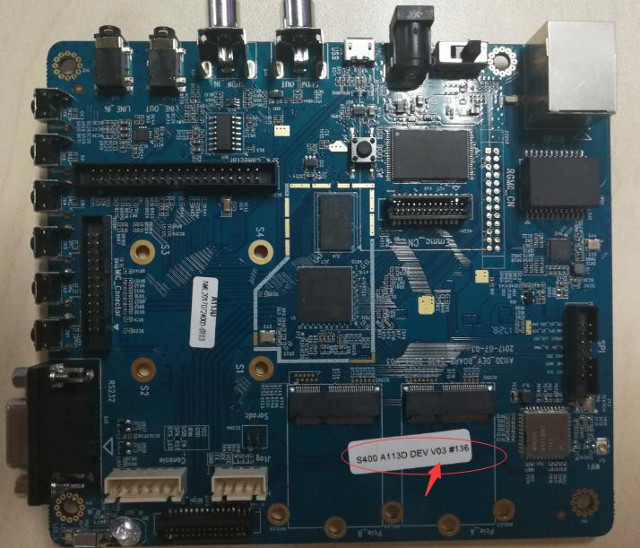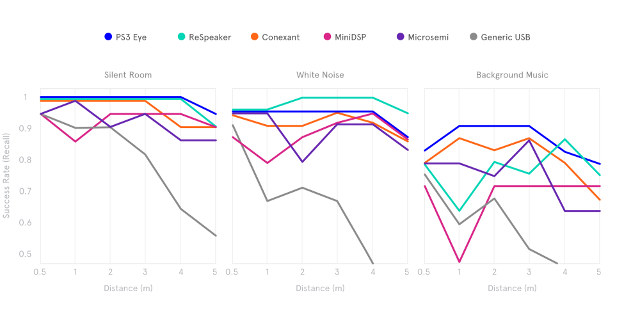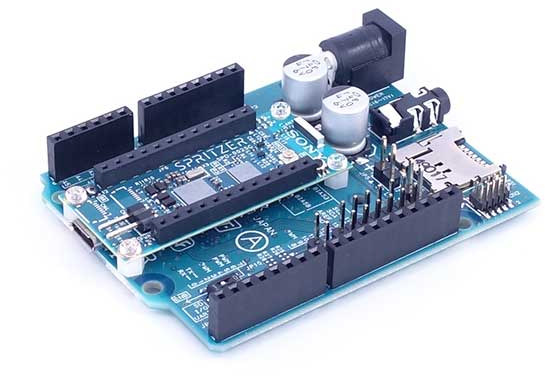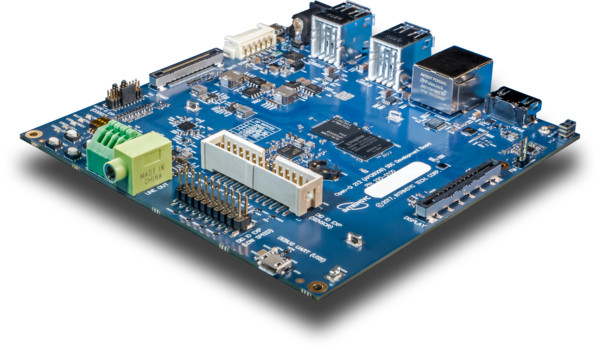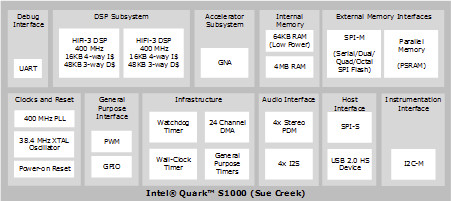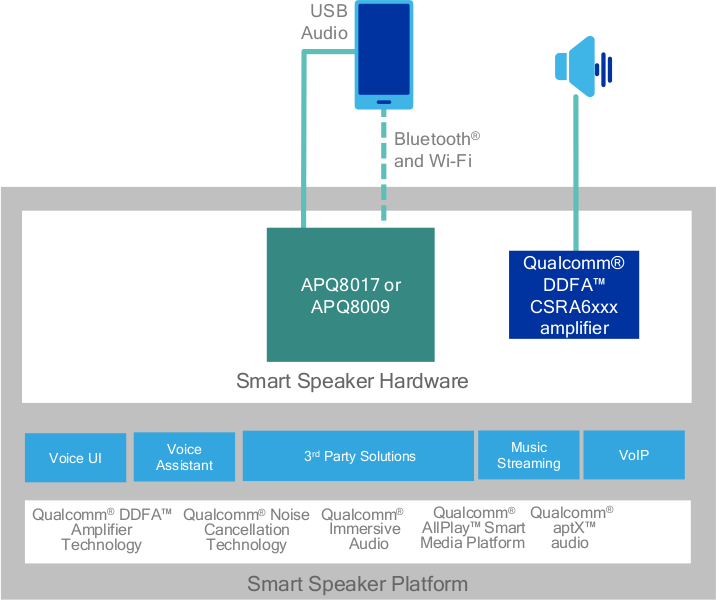Amlogic processors are mostly found in TVs and TV boxes, but the company is now apparently entering a new market with A111, A112, and A113 audio processors. I was first made aware of those new processors through Buildroot OpenLinux Release Notes V20170831.pdf document posted on their Open Linux website, where two boards with Amlogic A113D and A113X are shown. First, S400 board with the following key features/specifications: SoC – Amlogic A113D CPU System Memory – 1GB DDR3 Storage – 512MB SLC NAND flash Display I/F – MIPI interface Connectivity – Gigabit Ethernet SDIO WiFi/BT (AP6356S) Audio SPDIF_IN/SPDIF_OUT LINE_IN/LINE_OUT 2x Audio headers (MIC_Connector & SPK_Connector) USB – 1x USB 2.0 OTG Expansion – 2x PCIe ports Misc – 6x ADC Keys, IR_IN/IR_OUT, UART Interface (RS232) The second S420 board is based on A113X SoC, and comes with less features (no display, no Ethernet, no PCIe…), less memory: SoC – Amlogic A113X […]
Google Assistant News – AIY Voice Kit For Sale, Offline Support, 3rd Party Smart Speakers Announced
There’s been a lot of development related to Google Assistant in the last few days. First, Google provided an update for AIY Projects, with their AIY Projects Voice Kit now available for pre-order on Micro Center for $35 including a Raspberry Pi 3 board, making the kit virtually free, although you may also purchase it. Note that Micro Center blocks traffic originating from some countries, so I had to use Zend2 to access the site. [Update 10/09/2017: You can also get it from Seeed Studio for worldwide shipping] Google also announced the Speech Commands Dataset with 65,000 one-second long utterances of 30 short words, which they are in the process of integrating with the next release of the Voice Kit, and will allow the devices to respond to voice commands without the need for an Internet connection. So if you lose your Internet connection, or want to isolate your Voice […]
Those Charts Show The Benefits of Microphone Arrays for Hot Word Detection
Since I started looking more into smart speakers, including DIY ones such as the I made with Orange Pi Zero board + Google Assistant with a single microphone, I was told about the importance of microphone arrays, but so far, I had not seen any clear study or data about that. That changed today, as I came across a review of mic arrays by the makers of Snips Voice Platform. They tested five arrays connected to a Raspberry Pi 3 with the system, and also added a generic USB microphone to the mix. The results speak for themselves… In that experiment, they measured the rate at which a hot word was successfully detected by incrementally increasing the distance between 0.5 meters to 5 meters (16 ft), and for each distance, repeating the hot word 25 times at 3 second intervals using pre-recording to keep the voice level constant, and the […]
X-Powers AC108 is a Quad-Channel ADC Chip for Microphone Arrays
X-Powers, a company better known to supply PMIC “companion” chip for Allwinner processors, also made some audio chips including AC108 is a chip specifically designed for microphone arrays with support for 4 microphones, and an I2C + I2S output interface to the host processor. Microphone arrays are particularly useful for smart speakers, and especially hot word detection (voice activity detection) as single microphone setups like I use with Orange Pi Zero, may have trouble detecting hot words like “OK Google” in noisy environments (music playing, alarm ringing…). X-Powers AC108 specifications: 108 dB dynamic range (A-weighted) @ 0 dB boost gain -90 dB THD+N (total harmonic distortion plus noise) @ 0 dB boost gain 4x programmable boost amplifiers with 0dB to 45dB in 3dB step ADC sample rates supported – 8kHz,12kHz,16kHz, 22.05kHz, 24kHz, 32kHz, 44.1kHz, 48kHz,96kHz Analog mixer and digital mixer in record data path 4x fully differential microphone inputs: MIC1P/N […]
Sony Spritzer is an Arduino Compatible Board with Built-in GPS, Audio Codec
Look who is joining the maker community! Sony has showcased their Arduino compatible Spritzer board during the Maker Faire Tokyo on August 5-6. Despite lacking on-board network connectivity, the board is said to have been designed for IoT applications with features such as an integrated GPS and an advanced digital audio codec and amplifier. Sony Spritzer specifications: MCU – Sony CDX5602 ARM Cortex-M4F ×6 micro-controller clocked at up to 156 MHz with 1.5MB SRAM Storage – 8MB Flash Memory, micro SD card GNSS – GPS, GLONASS, supported Audio – 3.5mm audio jack Expansion I/Os Digital I/O Pins – SPI, I2C, UART, PWM ×4 (3.3V) Analog Pins – 6ch (3.3V range) Audio I/O – 8ch Digital MICs or 4ch Analog MICs, Stereo Speaker, I2S, CXD5247 audio codec with 192 kHz/24bit High-Resolution audio 2x camera interfaces USB – 1x micro USB port for programming Power Supply – Via Power barrel and Vin […]
Qualcomm Snapdragon 212 Boards – Intrinsyc Open-Q 212 and Kaynes Technology SKATE-212
Qualcomm Snapdragon 212 (APQ8009) quad core Cortex A7 processor is used in entry-level smartphones, but it’s also one of the processors which the company expects to use in their Smart Speaker Platform leveraging Google Assistant, Amazon Alexa, and other A.I. voice services. Two company has designed single board computers that can be used for this purpose: Intrisync Open-Q 212 and Kaynes Technology SKATE-212. Intrisync Open-Q 212 SBC Development Board Contrary to some other Open-Q boards, but not all, Open-Q 212 is not comprised of a baseboard and a system-on-module, as everything is soldered on a single PCB. Open-Q 212 specifications: SoC – Qualcomm Snapdragon 212 (APQ8009) quad core ARM Cortex A7 processor @ 1.267GHz with Adreno 304 GPU, QDSP6 DSP System Memory – 1GB LPDDR3 Storage – 8GB eMMC (non-POP) flash and micro SD card socket Connectivity – Ethernet, pre-scanned Wi-Fi 802.11n 2.4Ghz (WCN3610) with chip and U.FL antennas, Bluetooth 4.1 […]
Intel Quark S1000 “Sue Creek” Processor to Support On-Chip Speech Recognition
Intel may have announced plans to discontinue several of their IoT boards, but based on some documents I received, the company has not given up on the Quark family, although they may have given up on the Intel architecture for low power microprocessor, as Intel Quark S1000 – codenamed “Sue Creek” – will feature two Tensilica LX6 cores (yes, just like ESP32), and is designed to handle speech recognition at the edge (e.g. locally), so some of your voice commands should still work when Internet is down. Intel Quark S1000 key features and specifications: Digital Signal Processors Dual Tensilica LX6 cores @ 400 MHz with HiFi3 DSP Single precision scalar floating-point instructions 16KB 4-way I$; 48KB 4-way D$ Up to 2400 DMIPS, 3.2 GMACS (16×16), 800 MFLOPS of Compute Speech Accelerators A GMM (Gaussian Mixture Model) and neural network accelerator Low power keyboard and limited vocabulary recognition Up to 9.6 […]
Qualcomm Announces Audio Platforms for Smart Speakers, Headphones, and Hearables
Smart speakers are getting a lot of buzz recently with products like Amazon Echo or Google Home, and many home automation products are advertised with Amazon’s Alexa support, so that they can be controlled by voice commands. Qualcomm is now going after this market, and others audio markets via 5 new platforms for streaming audio, high resolution audio, wireless audio, USB -C audio devices – due to the “death” of the 3.5mm headphone jack -, and hearables. The five platforms include: Bluetooth and BLE Audio SoCs such as Qualcomm CSRA68100 for premium wireless speakers and headphones. The SoC comes with flash, DSP, a 2-ch audio CODEC, USB & I/Os interfaces. Qualcomm QCC3xxx entry-level Bluetooth audio SoC for mid to low-cost Bluetooth headsets and speakers. Qualcomm WHS9420 (192kHz/24-bit audio) and WHS9410 (entry-level) USB-C audio SoC for USB-C headphones Qualcomm DDFA Digital Amplifier Technology with CSRA6xxx amplifier Smart Speaker Platform shown above […]


